Main Page Current Research
Programs
Fermi Contours of Metal Surfaces and Ultrathin Films
Primary
Collaborators: Eli Rotenberg,
Advanced Light Source
Joerg Schaeffer,
University of Oregon
(now at University
of Augsberg)
Boris Krenzer,
University of Oregon
(now at University
of Essen)
Matthew Rocha, University of Oregon (now at HP Corvallis)
Oleg
Krupin, University
of Oregon
Clean and
Modified Group VIB Metal Surfaces
PRL 80, 2905 (1998); PRL 82, 4066 (1999); PRL 84, 2925 (2000); PRL 89,
216802 (2002)
JVST, 19 (4), 1983 (2001); J. Elect. Spectroscopy, 117-118, 57-70 (2001); J.
Elect. Spectroscopy, 126, 125 (2002)
For the past two decades, we have focused
much attention on the electronic structure of clean and adsorbate-modified
transition metal surfaces. Our
motivation for these studies has been to forge a connection between surface
electronic structure and low energy excitations such as surface phonons and
adsorbate vibrations. For example, our early studies of the surface Fermi
contours on W(110) [1]and Mo(110) motivated detailed measurements of surface
phonon dispersion relations. These have provided the best current example of a
surface phonon anomaly,[3, 4] a result which was qualitatively though not
quantitatively predicted by our Fermi contours and which has also motivated
serious theoretical attention.[5-7] Given the (at best) qualitative match
between our early experimental Fermi contours and recent calculated contours,
and the success of the latter in predicting the location of a phonon anomaly,
we were motivated to check our results to determine what went wrong. Our new results have proven quite interesting
and are indicative of interesting new physics. The primary results have been
published recently.[8-12] One key result is given in Fig. 1, which shows the
Fermi contours for various submonolayer coverages hydrogen atoms adsorbed onto
W(110). The contours of interest are labeled 1 and 2. The calculation
(and the previous experiment) observed just one contour, while we observe a
clear splitting between these two on W(110) and a barely-resolvable splitting
in Mo(110). We believe that this contour is split by the spin-orbit
interaction that, due to the lack of inversion symmetry caused by the surface,
breaks the Kramer's degeneracy.[13, 14] The calculations to date do not include
the spin-orbit interaction and thus do not predict this sizable
splitting. The nesting vector that provides the best match to the
observed phonon anomaly couples contours 1 and 2 on opposite side of the
surface Brillouin zone. The results suggest part of what went wrong
previously. The image in Fig 1 was collected in ~20 minutes. A similar
image could not have been collected 10 years ago - it would have taken longer
than sample stability would allow. Instead, the contour was pieced
together one point at a time. The much more rapid and systematic data
collection algorithm enabled by the ALS allowed this new and interesting result
to be obtained.
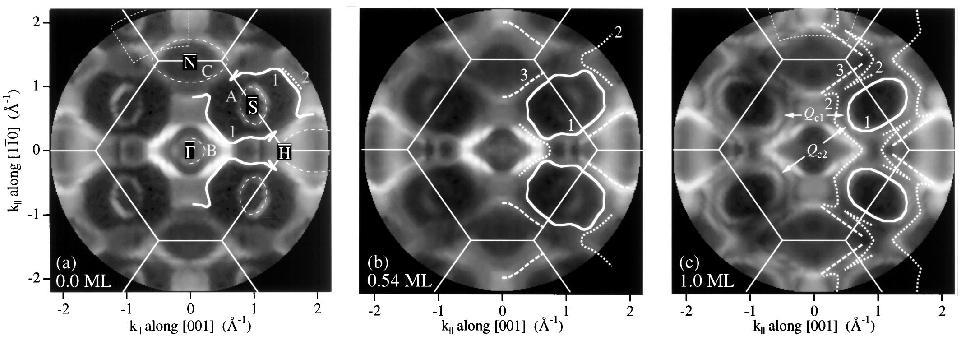
Fig. 1: Momentum-dependent Fermi level
photoemission intensity for a) clean W(110), b) 0.5 ML of hydrogen adsorbed
onto W(110), and c) 1 ML of hydrogen adsorbed onto W(110). Fermi contours
correspond to maxima in intensity and are indicated by white lines.
The splitting of this contour is interesting
in its own right. In line with previous work by LaShell, et. al.[13]
on Au(111), we have proposed the splitting of bands 1 and 2 discussed above
produces an unusual spin ordering on W(110). The spin-orbit interaction
is governed by the Hamiltonian

Since  is normal
to the surface plane
is normal
to the surface plane  is in the plane for a 2D surface state, the energy
splitting must be primarily between in-plane polarized spins. Fig. 2 shows the valence band ARP intensity at
the Fermi level for 1 ML of Li (for which the splitting is also observed) on
W(011) (Fig. 2, left) and on Mo(011) (Fig. 2, right). The arrows show the
proposed relative in-plane spin orientations, and were drawn in such a way that
states at -k|| have spins flipped relative to those at +k||,
as required by time-reversal symmetry. [14] Despite these unusual spin
structures, the surfaces have no net magnetic moment. Mo(110) exhibits a
Fermi contour that is insignificantly split compared to that of W(110), as
expected for this lighter (though isoelectronic) metal.
is in the plane for a 2D surface state, the energy
splitting must be primarily between in-plane polarized spins. Fig. 2 shows the valence band ARP intensity at
the Fermi level for 1 ML of Li (for which the splitting is also observed) on
W(011) (Fig. 2, left) and on Mo(011) (Fig. 2, right). The arrows show the
proposed relative in-plane spin orientations, and were drawn in such a way that
states at -k|| have spins flipped relative to those at +k||,
as required by time-reversal symmetry. [14] Despite these unusual spin
structures, the surfaces have no net magnetic moment. Mo(110) exhibits a
Fermi contour that is insignificantly split compared to that of W(110), as
expected for this lighter (though isoelectronic) metal.
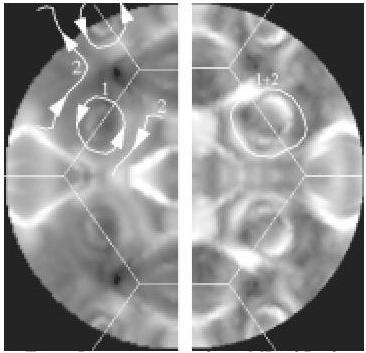
Fig. 2: Proposed
Fermi-level spin orderings for saturation coverage of lithium on W(110) (left)
and Mo(110) (right). The two contours labeled 1 and 2 are split by the
spin-orbit interaction on W(110), but the related splitting on Mo(110) is
barely resolved and is not visible in these contours.
Recently, using spin- and angle-resolved
photoemission in collaboration with Michael Hochstrasser and Jim Tobin at Lawrence Livermore
National Lab, we have directly observed the spin polarization of these two
states for W(110)-(1x1)H. [12] The key
result is shown in Fig. 3. This shows spin-resolved spectra of the S1-S2
doublet near the Fermi energy, for both tangential and longitudinal spin
components. The tangential components clearly resolve the splitting and
prove that the spin orientation is in-plane, in the orientation predicted by
the spin-orbit Hamiltonian.
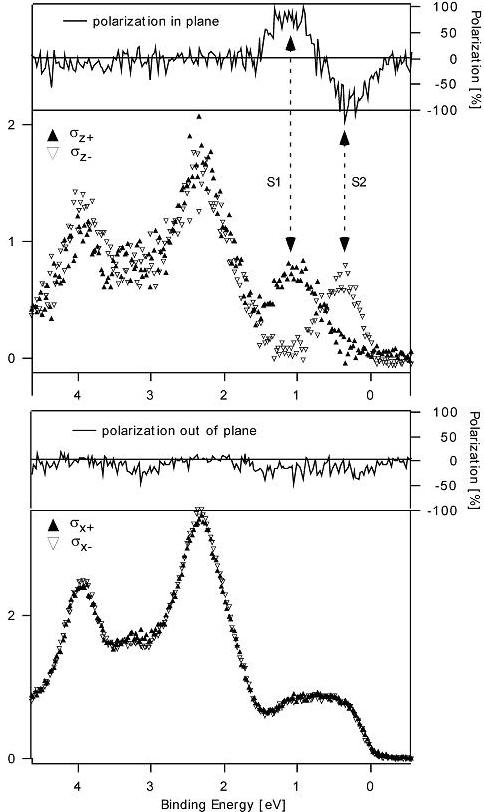
Fig. 3: Spin-resolved photoemission of the
state S1 and S2, showing that they are spin-polarized in opposite direction
with the spin orientation in the surface plane.
These states and their Fermi contours are
interesting because they have a profound effect on the elementary excitations
at these surfaces. For example, the observed spin splitting implies that spin
conservation needs to be taken into consideration as part of this
electron-phonon coupling process that leads to the phonon anomalies observed on
these surfaces. Moreover, there will be distinct spin excitations at
these surfaces, and the dispersion relations of these will be determined by the
spin ordering of these contours. Finally, these spin orderings will very
likely impact the interfacial magnetic structure between a heavy metal like
tungsten and a magnetic metal.
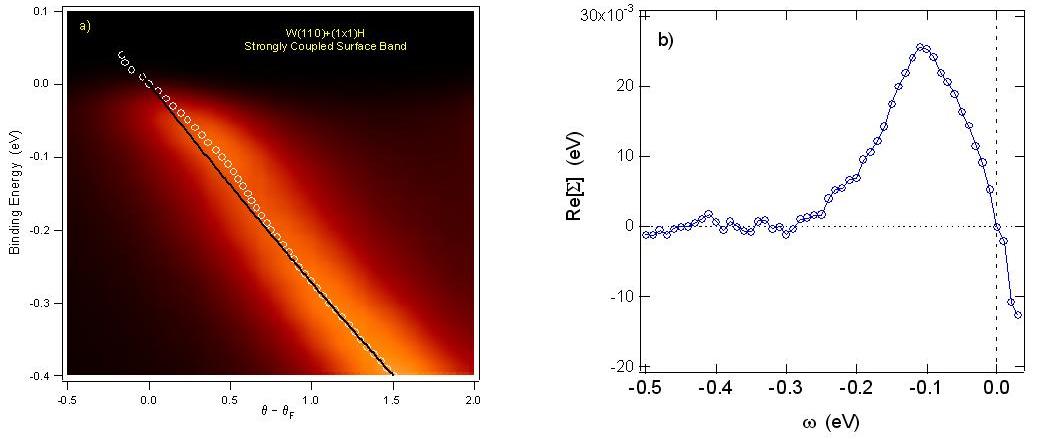
Fig. 4: High resolution band map (left) and
the real part of the derived electron-phonon self-energy function for the S1
surface state on W(110)-(1x1)H.
Our crowning achievement in studying the
H/W(110) system is the direct observation of coupling between these surface
localized electron states with the adsorbed hydrogen vibrational modes. [10,
11] The data in figure 1 provide a nice way to conceptualize this
coupling. If we were to start with a full monolayer coverage, and then
slowly and uniformly remove hydrogen layer, the Fermi contours would slowly
evolve from the right panel to the left. Oscillating the layer rather
than removing it would cause the electron gas to respond in similar
fashion. Such a conceptual motion corresponds directly to the
zero-wave-vector symmetric stretch hydrogen phonon mode. So, as the layer
vibrates, it naturally couples to sizable reorganization of the electronic
structure, as manifested by the Fermi contours. To the extent that
electronic motion lags the vibrational motion, such a mechanism implies a
breakdown of the Born-Oppenheimer approximation. Fig. 4 shows directly
the perturbations on the underlying quasiparticle dispersion relations driven
by this electron-phonon coupling.
Surface
Phonon Anomalies on Mo(x)Re(1-x) Alloy Surfaces
preprint
Recently,
in collaboration with Ward Plummer at the University ot Tennessee and Michio
Okada at the University of Osaka, we have begun to extend this work on
electron-phonon coupling to simple binary alloy surfaces. We have initiated our
work with Mo-Re alloys, as these have been well-characterized by other
techniques. Our motivation for moving in this direction is to study the impact
of compositional disorder on material properties - subject of prime focus in
many materials systems, ranging from simple metal alloys to complex oxides and
compound semiconductors. The macroscopic properties of interest are driven
microscopically by manybody couplings between the electron gas and various low-energy
bosonic degrees of freedom. Disorder will broaden electronic and the bosonic
modes to varying degrees, and in the limit of very strong damping, one or more
of these modes can even become localized. The question of how the variously
damped modes remain coupled is of enduring fundamental interest and also of
much practical importance.
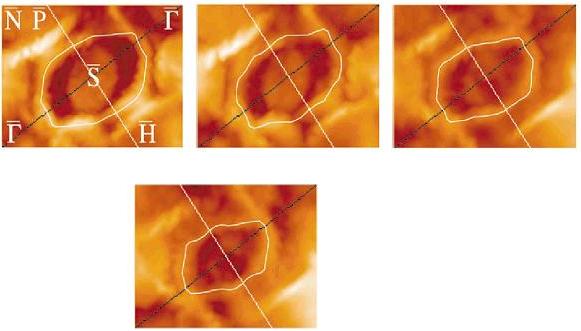
Fig. 5: Variation of the hole
pocket as a function of rhenium concentration on MoRe alloy surfaces.
Figure 5 shows the evolution
of the hole pocket that drives the phonon anomaly on Mo(110)[15, 16] as a
function of alloy composition. As the
rhenium concentration is increased, the hole pocket decreases in size. This is qualitatively as expected based on the
rigid band model of alloys. Rhenium has
one more valence electron than the host molybdenum, and this extra electron
will be donated to the host band structure, thereby raising the Fermi level. Alloying naturally decreases the size of this
hole pocket. Moreover, our results predict the evolution of the position of the
phonon anomaly as the composition is changed[17] with good precision, though
not the width. We have also undertaken
an accurate test of the rigid band model for this system.
Spin
Density Wave Band Gap and Phase Diagram on Cr(110)
PRL 83, 2069
(1999); Surface Science 454-456, 885 (2000).
We have recently
extended our measurements of Mo(110) and W(110) to the more technically
challenging though somewhat more exotic Cr(110) surface. [15] Our goal was to understand how the well-known bulk
itinerant antiferromagnetism in chromium is modified near a surface. [16]
Fermi contours for the clean surface are shown below.
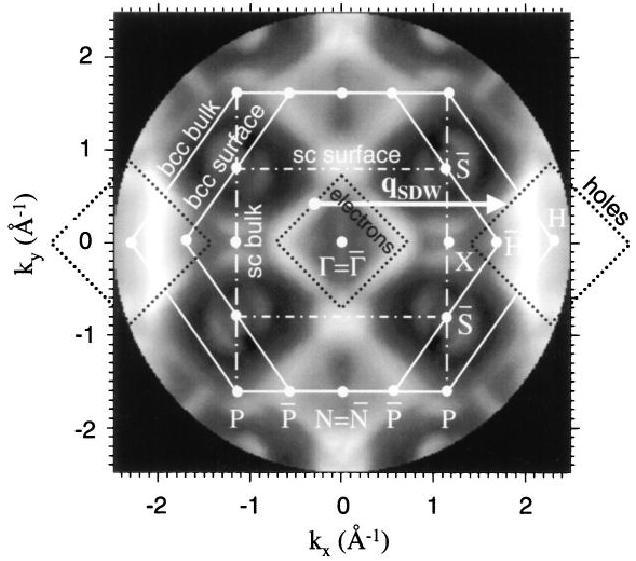
Fig. 6: Surface BZ and bulk BZ
superimposed on ARPES Fermi level intensity plot. SDW nesting occurs between
the electron jack at G and the hole jack at H. The data provide an
estimate for qSDW = 0.95 ± 0.05 G–H.
The derived nesting vector is close to
that of the bulk. Indeed, these are bulk states that propagate to the
surface, and are thus the ones that drive the SDW state. We have measured
the SDW band gap, and have shown that it exists over much of the electron
jack. This is the first direct, momentum-resolved confirmation of an
electronic driving force for SDW formation. We have also measured the
temperature dependence of the SDW band gap, and we find an enhanced surface
Néel temperature.

Fig. 7: Band maps of
Cr(110) films as a function of thickness in at T=50K in the vicinity of the SDW
band gap and band backfolding. The unsplit
and split bands are associated with commensurate and incommensurate SDW phases,
respectively. The panel on the right
shows the smooth evolution of the splitting as a function of temperature.
More recently we have used angle-resolved photoemission
to probe the SDW commensurability and phase behavior of Cr(110) films. A sampling of the relevant results is shown in
Fig. 7, which provides band maps along the  direction of the
surface Brillouin zone. This line
intersects the electron octahedron that helps drive the SDW ground state. These data were collected at T = 50K, from a
film with a wedge-shaped thickness profile that allows straight-forward
measurements as a function of thickness. The thinner film shows a single backfolded
band that is related to a commensurate SDW state, while the thicker film shows
two backfolded bands associated with an incommensurate SDW. We have used results like to these to map the
SDW commensurability and phase diagram as a function of thickness and T.
direction of the
surface Brillouin zone. This line
intersects the electron octahedron that helps drive the SDW ground state. These data were collected at T = 50K, from a
film with a wedge-shaped thickness profile that allows straight-forward
measurements as a function of thickness. The thinner film shows a single backfolded
band that is related to a commensurate SDW state, while the thicker film shows
two backfolded bands associated with an incommensurate SDW. We have used results like to these to map the
SDW commensurability and phase diagram as a function of thickness and T.
Electron
states in 1D and Quasi-1D systems
PRL 87, 157 (2001); PRL 91,
066401 (2003); Surface
Rev. Lett. 9, 1029 (2002).
One-dimensional (1D) solids are of great
interest because of the many unusual phenomena they may exhibit, such as
Peierls instabilities and deviations from Fermi liquid behavior.
Photoemission appears particularly suited to probe these exotic electronic
properties. An important topic is the effect of Peierls instabilities on
the periodicity of experimentally determined electron bands. In the
simplest case of a half-filled band, a Peierls distortion leads to a new
Brillouin zone of half the original width. More generally, a charge
density wave (CDW) can induce a zone that is incommensurate with the underlying
lattice. It lifts the original symmetry of the lattice and leads to a
total loss of translational symmetry. Electronic band structure, often
derived from translational invariance, can still exist in systems with
incommensurate periodic potentials. One of the most intriguing compounds
in this respect is NbSe3 with its two incommensurate charge density
waves. This system has been heavily studied by a variety of transport and
optical techniques, yet the underlying electron states that drive the CDW
states had not previously been carefully studied, largely due to the
needle-like macroscopic texture of the material.
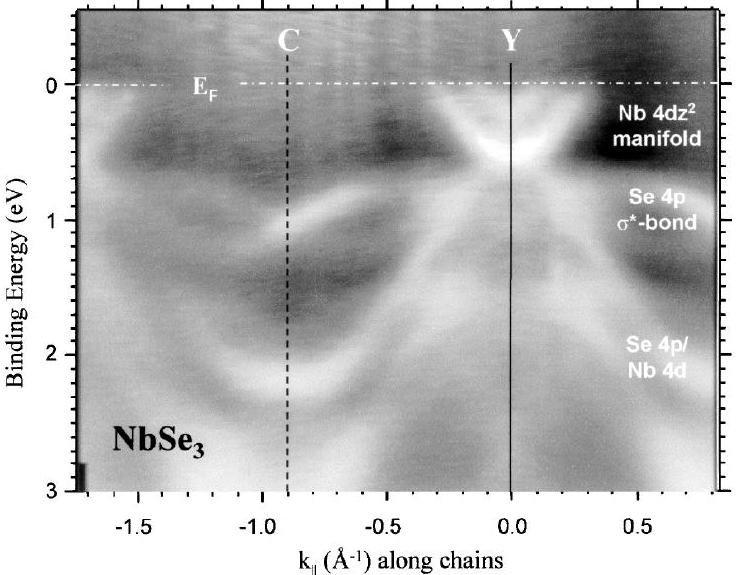
FIG. 6: Electronic band structure along the NbSe3 whiskers. Near the
Fermi level two sets of parabolic bands are clearly discernible. They originate
from Nb 4d states and supply the nesting conditions for the CDWs.
We have recently studied this system’s
electron states with high resolution photoemission. [17] The prime result is shown in Fig. 6
above. This shows the electronic band structure along the direction of
high dispersion for this material. The two parabolic bands near the Fermi
level (zero binding energy) provide the necessary nesting conditions that drive
the CDW ground states.
Acknowledgement
This work was carried out in part at the
Advanced Light Source at Lawrence Berkeley National Laboratory which is supported by the U.S. Department
of Energy. Financial support from the USDOE under grant DE-FG06-86ER45275 is
gratefully acknowledged.
References
1. Gaylord, R.H., K. Jeong, and S.D.
Kevan, Experimental Fermi Surface for Clean and Hydrogen-Covered W(011). Phys.
Rev. Lett., 1989. 62: p. 2036.
2. Jeong, K., R.H. Gaylord, and S.D. Kevan, Experimental Fermi Surface of
Mo(011). Phys. Rev. B, 1989. 39: p. 2973.
3. Hulpke, E. and J. Lüdecke, Hydrogen-Induced Phonon Anomaly on the W(110)
Surface. Phys. Rev. Lett., 1992. 68(18): p. 2846-2849.
4. Balden, M., et al., Surface Phonons on the clean and H-covered W(011)
surface measured with EELS. Surface Sci., 1994. 307-9: p. 1141.
5. Bungaro, C., S.d. Gironcoli, and S. Baroni, Theory of the anomalous Rayleigh
dispersion at H/W(110) surfaces. Phys. Rev. Lett., 1996. 77: p. 2491.
6. Kohler, B., et al., H-Induced Instability of Mo(011). Zeitschrift f. Physikalische
Chemie, 1996. 197: p. 193.
7. Kohler, B., et al., Frustrated H-Induced Instability of Mo(011). Phys. Rev. Lett., 1995. 74: p. 1387.
8. Rotenberg, E., J.W. Chung, and S.D. Kevan, Spin-orbit-coupling induced
surface band splitting in Li/W(110) and Li/Mo(110). Phys. Rev. Lett., 1999. 82:
p. 4066.
9. Rotenberg, E. and S.D. Kevan, Evolution of Fermi level crossings vs. H
coverage on W(110). Phys. Rev. Lett., 1998. 80(13): p. 2905.
10. Rotenberg, E. and S.D. Kevan, Electron-Phonon Coupling in W(110)-(1x1)H. J.
Elec. Spect., 2002. 126: p. 125.
11. Rotenberg, E., J. Schaefer, and S.D. Kevan, Coupling between Adsorbate
Vibrations and an Electronic Surface
State. Phys. Rev. Lett.,
2000. 84: p. 2925.
12. Hochstrasser, M., et al., Spin-resolved photoemission of surface states of
W(110)-(1x1)H. Phys. Rev. Lett., 2002. 89: p. 216802.
13. LaShell, S., B.A. McDougall, and E. Jensen, Spin splitting of an Au(111)
surface band observed with angle resolved photoelectron spectroscopy. Phys.
Rev. Lett., 1996. 77(16): p. 3419-22.
14. Kittel, C., Quantum Theory of Solids. 1987, New York: Wiley.
15. Hulpke, E. and J. Lüdecke, The giant surface phonon anomaly on hydrogen
saturated W(110) and Mo(110). Surface Sci., 1992. 272: p. 289.
16. Hulpke, E. and J. Lüdecke, The giant surface phonon anomaly on hydrogen
saturated W(110) and Mo(110). Surface Sci., 1993. 287/288: p. 837-841.
17. Okada, M., et al., Shifting the surface Kohn anomaly of H-saturated Mo(110)
by alloying the bulk with Re. Surface Sci., 2002. 498: p. L78-84.
18. Schäfer, J., et al., Direct Spectroscopic Observation of the Energy Gap
Formation in the Spin Density Wave Phase Transition at the Cr(110) Surface.
Phys. Rev. Lett., 1999. 83: p. 2069.
19. Fawcett, E., Spin-density-wave antiferromagnetism in chromium. Rev. Mod.
Phys., 1988. 60: p. 209.
20. Schäfer, J., et al., High Temperature Symmetry Breaking in the Electronic
Band Structure of the Quasi-One-Dimensional Solid NbSe3. Phys. Rev. Lett.,
2001. 87(19): p. 196403.



